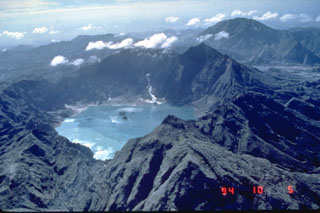Report on Pinatubo (Philippines) — 21 September-27 September 2022
Smithsonian Institution / US Geological Survey
Weekly Volcanic Activity Report, 21 September-27 September 2022
Managing Editor: Sally Sennert.
Please cite this report as:
Global Volcanism Program, 2022. Report on Pinatubo (Philippines) (Sennert, S, ed.). Weekly Volcanic Activity Report, 21 September-27 September 2022. Smithsonian Institution and US Geological Survey.
Pinatubo
Philippines
15.13°N, 120.35°E; summit elev. 1486 m
All times are local (unless otherwise noted)
On 25 September PHIVOLCS warned of potential lahars around Pinatubo due to intense rains from a typhoon expected during 25-26 September. Significant deposits from 1991 pyroclastic density currents on the W flank may be remobilized, generating lahars down major drainages in that watershed. PHIVOLCS noted that the communities of San Marcelino, San Narciso, San Felipe, and Botolan, Zambales Province, and communities in Tarlac and Pampanga Provinces may be affected by lahars and flooding.
Geological Summary. Prior to 1991 Pinatubo volcano was a relatively unknown, heavily forested lava dome complex located 100 km NW of Manila with no records of historical eruptions. The 1991 eruption, one of the world's largest of the 20th century, ejected massive amounts of tephra and produced voluminous pyroclastic flows, forming a small, 2.5-km-wide summit caldera whose floor is now covered by a lake. Caldera formation lowered the height of the summit by more than 300 m. Although the eruption caused hundreds of fatalities and major damage with severe social and economic impact, successful monitoring efforts greatly reduced the number of fatalities. Widespread lahars that redistributed products of the 1991 eruption have continued to cause severe disruption. Previous major eruptive periods, interrupted by lengthy quiescent periods, have produced pyroclastic flows and lahars that were even more extensive than in 1991.
Source: Philippine Institute of Volcanology and Seismology (PHIVOLCS)

